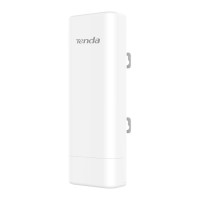connect to your device.
For WEB security mode, most smart phones only support key 1, so we recommend that you
select key 1 of this device.
Enter a WEP key. The length of the character string is a 5 or 13.
Enter a WEP key. The length of the character string is 10 or 26.
Parameter description of WPA-PSK, WPA2-PSK and WPA-PSK&WPA2-PSK
It is designed for home and small office networks and doesn't require an authentication server. Each WLAN
network device encrypts the network traffic using a 256 bit key. This key may be entered either as a string of 64
hexadecimal digits, or as a passphrase of 8 to 63 printable ASCII characters. If ASCII characters are used, the 256
bit key is calculated by applying the PBKDF2 key derivation function to the passphrase, using the SSID as the salt
and 4096 iterations of HMAC-SHA1.
Select WPA encryption type.
AES: AES is short for Advanced Encryption Standard. This encryption algorithm ensures a
higher wireless rate.
TKIP: TKIP is short for Timing Key Integrity Protocol. Wireless rate can only reach 54Mbps
with this algorithm.
TKIP&AES: Compatible with TKIP and AES. The wireless client can use either AES or TKIP
algorithm to connect to the WiFi.
Enter a security key that is either 8 - 63 ASCII characters or 8 - 64 Hex characters.
You can configure security key's update interval here within the range from 60 to 99999
seconds. If set to 0, the key will not be updated.
Parameter description of WPA and WPA2
WPA is opposed to WPA-PSK and is also referred to as WPA-802.1X mode. It is designed for enterprise networks
and requires a RADIUS authentication server. This requires a more complicated setup, but provides additional
security (e.g. protection against dictionary attacks on short passwords). Various kinds of the Extensible
Authentication Protocol (EAP) are used for authentication. WPA-Enterprise mode is available with both WPA and
WPA2.
Enter the radius server IP address for authentication.

